Five Strategies for Improving Their Workplace. (Spoiler: They’re similar to the corporate world)
By: Angela Kolosky, AIA, LEED AP BD+C // Associate Principal, Healthcare Planner
+ Joe Mayer, AIA // Associate Principal, Designer
When we ask healthcare workers what could make their work environment better, they always start with patient care. While it’s wonderful they’re so dedicated to their jobs, part of our job is to care about them when we consider the design of a great healthcare space. So when we press them a little harder to focus on their own needs, healthcare workers often point to many of the same things preferred by office workers. Different worlds, but common needs.
A huge number of Americans – some estimate 12 percent of all workers [ 1 ] – are employed in healthcare. But even best-practice workplace standards (such as the WELL building standard, which advocates design for the health and wellness of occupants) focus almost exclusively on corporate office space. As planners and designers, we can better meet the needs of healthcare workers by drawing inspiration from best practices in these other markets.
While there have been gradual moves, the COVID-19 pandemic has shined a bright light on what needs to change. It’s time to do something that improves the experience of our healthcare heroes. To follow are five strategies for improving the healthcare workplace. Perhaps a lasting silver lining on the other side of this pandemic will be a lasting realization of how the quality of the healthcare work environment affects the quality of care provided.
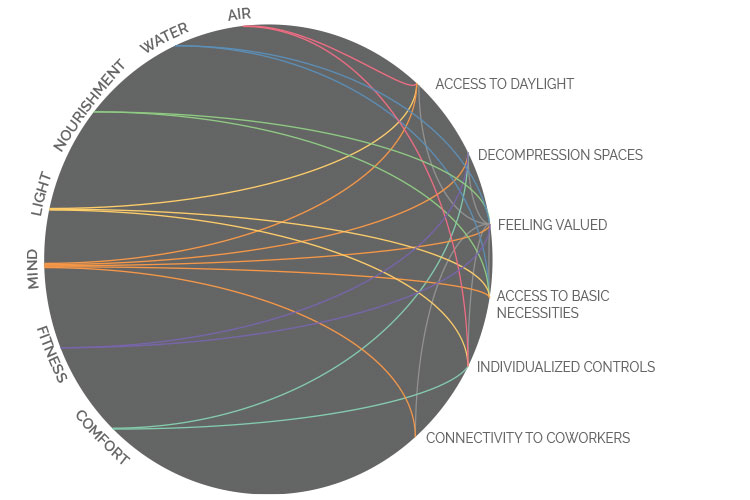
1. ERGONOMIC CONTROL
Thoughtful ergonomics is more than a well-designed desk chair – it’s about supporting workers throughout their day and providing customization of their work spaces in various forms.
Why it matters: 33% of workplace injuries and illnesses stem from musculoskeletal disorders. [ 2 ]
Providing staff comfort and individualized control at both the bedside and workstations reduces discomfort and stressors. All of which helps keep staff healthy — and better focused on patient care.
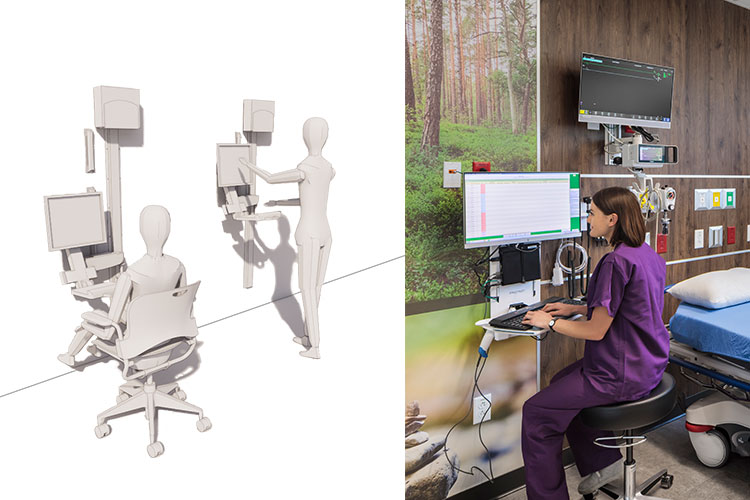
2. SENSORY CONTROL
A key indicator in any office or work environment is the Indoor Environmental Quality (IEQ), which is most significantly impacted by lighting, acoustics, and climate. In healthcare environments, these elements are too often designed around the comfort of patients — at the exclusion of staff. It’s critical to consider both populations in the design of good patient care spaces.
Why it matters: Allowing staff individualized control when possible helps maintain circadian rhythms, which in turn helps regulate mood and keeps employees happier. [ 3 ]
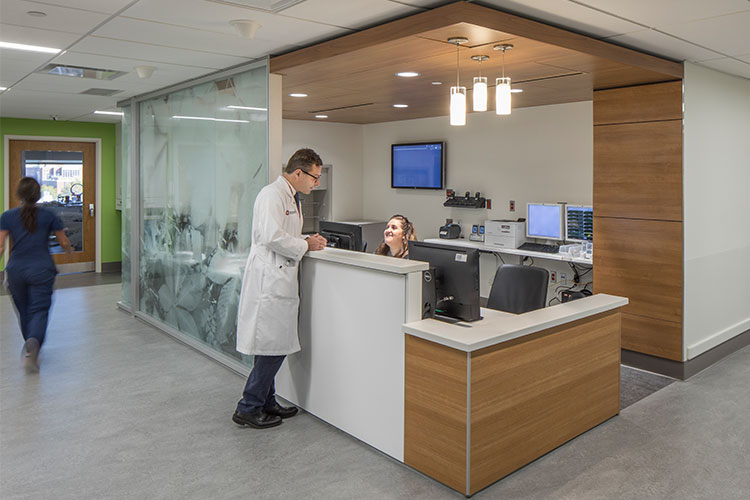
Lighting Controls
In many patient care areas, lighting levels are mandated by federal guidelines. It’s important to provide flexible staff areas where light levels can be adapted with dimmers or through the use of individual task lighting. This also means orienting workstations to reduce glare from natural light.
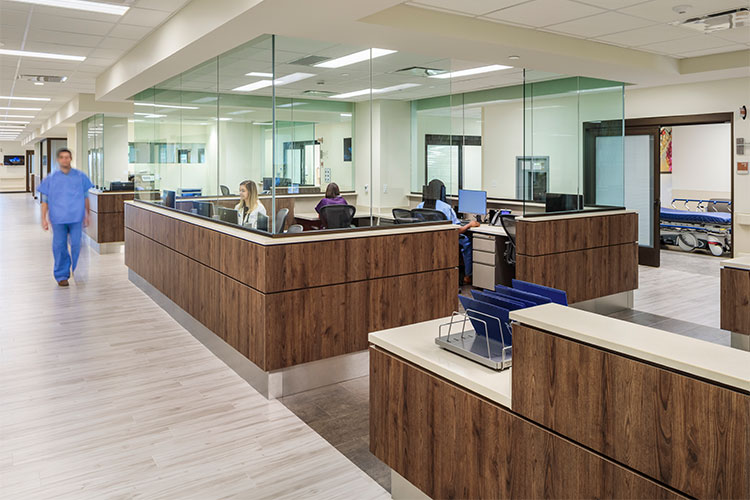
Acoustics
Hospitals are notoriously noisy places and healthcare work can require extreme focus to minimize errors. Acoustical separation when desired and alternative work locations help improve acoustical comfort. Acoustically absorptive materials and sound masking can help mitigate noise in staff areas.
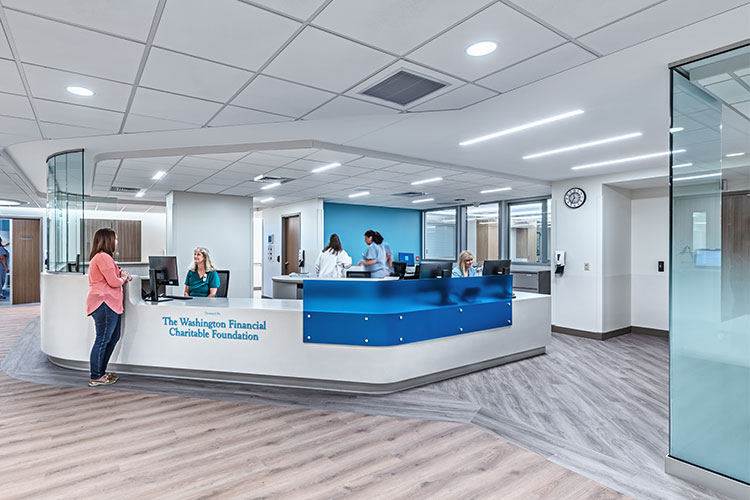
Climate
Providing more individualized control of specific staff work areas can help improve staff focus and performance. This could mean control of a thermostat in a staff respite room or simply access to a breezy outdoor space when desired.
3. WORKDAY DECOMPRESSION SPACES
Providing various types of staff spaces beyond patient care zones (such as private meditation rooms, small conference rooms, and staff break rooms with access to natural light) allows for staff to decompress over the course of the day or right after an event. The quality of care provided by a hospital is a direct link to satisfaction and value that healthcare workers feel.
Why it matters:Providing and encouraging staff to use decompression spaces dedicated to them shows them that you care about them as individuals. Mental health in healthcare workers has taken center stage with the current pandemic, but even after this has passed, staff will need places to manage their own health throughout the day.
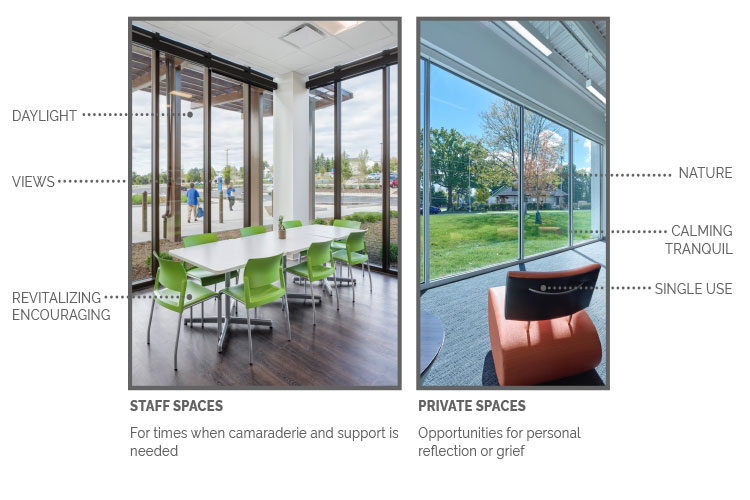
4. TRANSITIONAL DECOMPRESSION SPACES
Like all workers, healthcare staff have work and home stressors. Yet few jobs have such impacts when those stressors start to overlap. The COVID-19 pandemic has shown the importance of the process to decompress before transitioning from work to home and vice versa.
Why it matters:Healthcare workers need to be focused at work; when their shift ends, their compassion buckets needs to have a little left for home. Allowing for a decompression zone on both sides of the work/life spectrum gives them a chance to re-energize and focus towards the next endeavor. This zone could be a garden between a staff entry and their car, a convenient coffee shop, or well-placed inspirational artwork. It can even be as simple as a well-appointed, aptly located locker room with the right amount of personal space.

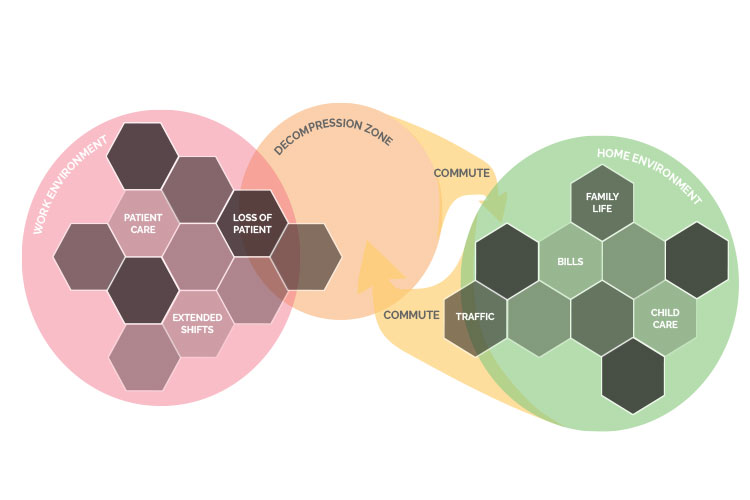
5. ACCESS TO BASIC NECESSITIES
In traditional office environments, we often take for granted how easy it is to access basic necessities like daylight, convenient food and drink, and easy opportunities to collaborate. These common luxuries are often not available to clinical staff. And that can conflict with patient care and safety.
Why it matters:Giving staff access to these basic necessities improves their mental focus and shows how much they are valued and the work they provide.
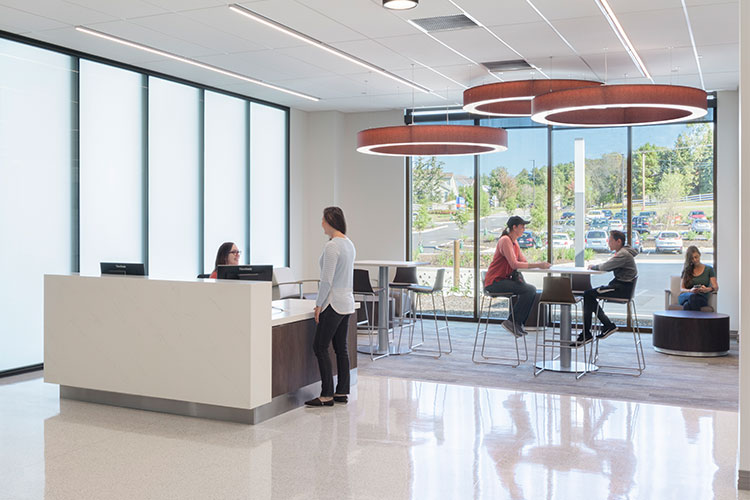
Studies have shown that access to daylight and views is critical to a body’s regulation and health. Providing staff adequate access increases alertness, reduces fatigue and eye strain, and improves how they feel.
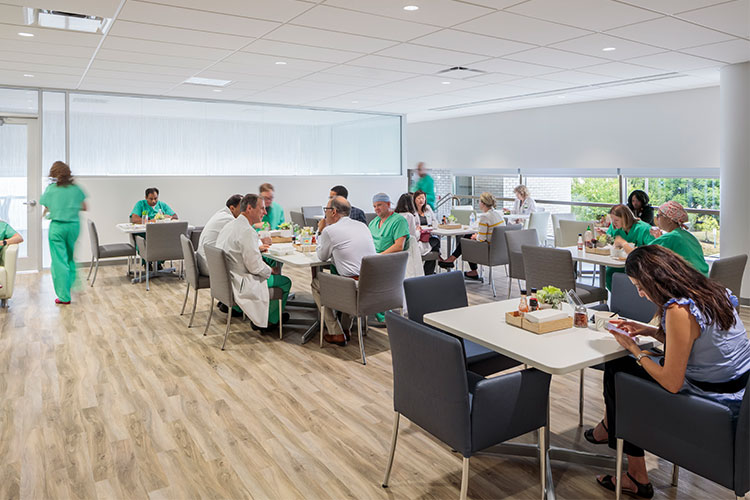
Patient care is demanding work, so the ability to stay adequately hydrated helps improve overall health as well as staff comfort and focus during the workday.

Providing workspaces that facilitate multiple scales of interaction between staff – from the two-person huddle room to larger staff stations where clinical staff can congregate – allows better collaboration on patient care and the mental support and camaraderie so important to any work environment.
We believe in a post-COVID-19 world, that collaboration will continue to be king. We’re already seeing it in the way we’re working this week. Workplace design will integrate materials and safety protocols from Healthcare, and Healthcare will integrate concepts of ergonomics and office architecture to promote wellness. We’re eager to help influence how this synergy will benefit workers in the future.

Angela offers a unique perspective to healthcare planning. Her love for healthcare design stems from her Master’s thesis, “The Importance of Design Decisions in Patient and Staff Outcomes in Ambulatory Infusion Centers,” which focused on how design can create positive outcomes for patients and staff. Angela brings this thinking to every project and has a passion for creating impactful, positive spaces for a critical and vulnerable population. With building performance background data, one can begin to see the impact that initial phases of planning and design have on the end user, which in turn helps healthcare planning and design improve with each new phase or project.

As a healthcare designer, Joe believes that great planning and design can be foundations for successful operations and positively impact patients, families and care providers. Driven by the simplicity of design, he seeks to incorporate natural light and views to nature with a clean, calm aesthetic, keeping the patient experience at the forefront of his mind. His responsiveness stems from passion for every detail in a project, enabling seamless transitions from initial conceptual design phases to construction documentation.
References
1. [ https://www.kff.org/other/state-indicator/health-care-employment-as-tota... ] ↩
2. [ OHSA Ergonomics; https//www.osha.gov/SLTC/ergonomics/ ]↩
3. [ Walker, W. H., 2nd, Walton, J. C., DeVries, A. C., & Nelson, R. J. (2020). Circadian rhythm disruption and mental health. Translational psychiatry, 10(1), 28. https://doi.org/10.1038/s41398-020-0694-0 ]↩
